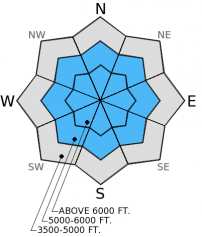| Saturday | Saturday Night | Sunday | |
|---|---|---|---|
| Cloud Cover: | Continued precipitation with lowering snow levels. | Snow showers | Mostly cloudy |
| Temperatures: | 34-38 deg. F. | 29-31 deg. F. | 32-37 deg. F. |
| Wind Direction: | S | SW | SW |
| Wind Speed: | 8-24 | 14-29 | 8-21 |
| Snowfall: | 1 in. | 3-4 in. | 0 in. |
| Snow Line: |
Swan Range
How to read the forecast
Storm snow from Thursday and Friday was very reactive yesterday and the snowpack still needs time to adjust to this new load. Storm slab avalanches are likely above 5000 feet, with the possibility of avalanches breaking in deeper layers. Cautious route finding and conservative decision making are essential.

3. Considerable
?
Above 6500 ft.
3. Considerable
?
5000-6500 ft.
2. Moderate
?
3500-5000 ft.
- 1. Low
- 2. Moderate
- 3. Considerable
- 4. High
- 5. Extreme
-
Type ?
-
Aspect/Elevation ?

-
Likelihood ?CertainVery LikelyLikelyPossible
 Unlikely
Unlikely -
Size ?HistoricVery LargeLargeSmall

The Swan Range was highly favored in this past storm system. It can take several days for the snowpack to adjust to this new load. It is best to avoid steep, exposed terrain until the new snow has had time to settle. Human triggered avalanches are likely in steep terrain in the Swan Range today. Look for obvious signs of instability like recent avalanche activity, cracking, and collapsing.
-
Type ?
-
Aspect/Elevation ?

-
Likelihood ?CertainVery LikelyLikelyPossible
 Unlikely
Unlikely -
Size ?HistoricVery LargeLargeSmall

A layer of weak snow exists in the snowpack about 2 feet down that readiliy failed in stability testing in previous observations. Also, weak faceted snow near the ground exists in all ranges in the advisory area. It remains possible to trigger an avalanche in these deep layers. Avoid terrain where triggering these layers is most likely such as in steep, rocky areas with shallow snow. Dig into the snow and assess each area you intend to ski or ride.
Yesterday we observed a very sensitive "upside down" storm layer in Noisy Basin. The snowpack will need time to adjust to this new load. Continue to make conservative decisions in the backcountry and avoid steep terrain until the snow has had time to adjust to the recent burden. Though seemingly less reactive than in previous observations, weak (faceted) snow near the ground exists in most locations in the advisory area. Consider the places where you are most likely to trigger an avalanche on these layers such as steep, rocky terrain. Even though the obvious signs of instability such as collapsing (whumpfing), shooting cracks, or recent avalanche activity may not be present, it remains important to seek out instability in the snowpack. The snow is still fairly shallow so digging to the ground to assess problem layers does not take much time. It is also important to note the distribution of these early issues in the snowpack as the snow continues to pile up.
Yesterday, we traveled in to Noisy Basin in the Swan Range. The big story there is the storm snow that accumulated from Thursday into Friday morning. Noisy Basin SNOTEL recorded 1.5 inches of snow water equivalent (SWE) and we observed a little over a foot of new snow on top of the Thanksgiving crust. Temperatures were on the rise for the duration of the storm which created an upside down storm layer.
This storm snow at mid-elevations was very reactive. We were able to easily trigger storm slabs on steep cut banks from the road just by approaching the slope (photo1 and 2). Results from extended column tests reinforced our initial observations. We were able to partially propagate fractures with easy force above the thanksgiving crust and full propagation occurred with moderate force below the crust. We found weak (faceted) snow near the ground in multiple pit locations.
In the past 48 hours the Swan Range recieved over 1.5 inches of snow water equivalent and 12-16 inches of new snow. For today, expect temperatures to climb above freezing at mid-elevations and then begin to fall by late afternoon. Continued precipitation will become more showery by the afternoon and into the evening. Currently mountain temperatures in the Swan Range are in the low to mid 30s.
| 0600 temperature: | 35 deg. F. |
| Max. temperature in the last 24 hours: | 35 deg. F. |
| Average wind direction during the last 24 hours: | S |
| Average wind speed during the last 24 hours: | 5 mph |
| Maximum wind gust in the last 24 hours: | 30 mph |
| New snowfall in the last 24 hours: | 3 inches |
| Total snow depth: | 43 inches |
This advisory applies only to backcountry areas outside established ski area boundaries. This advisory describes general avalanche conditions and local variations always occur. This advisory expires at midnight on the posted day unless otherwise noted. The information in this advisory is provided by the USDA Forest Service who is solely responsible for its content.





























